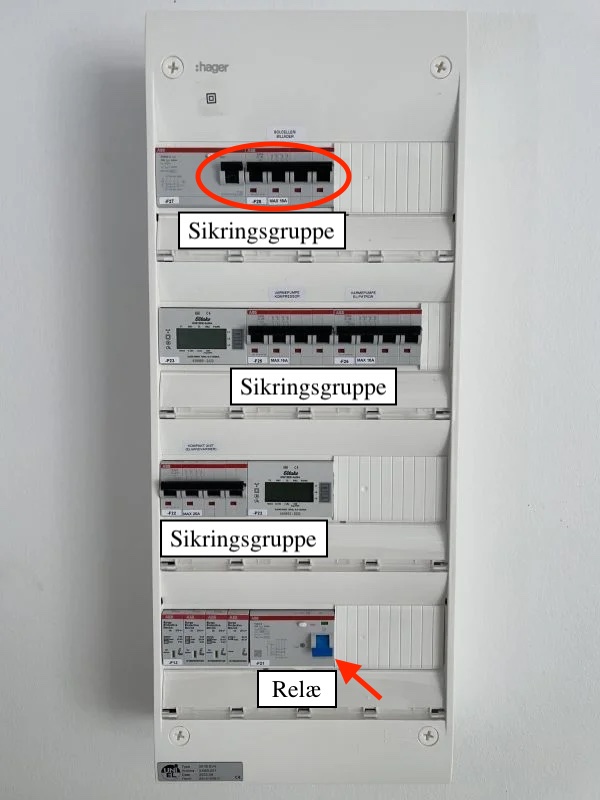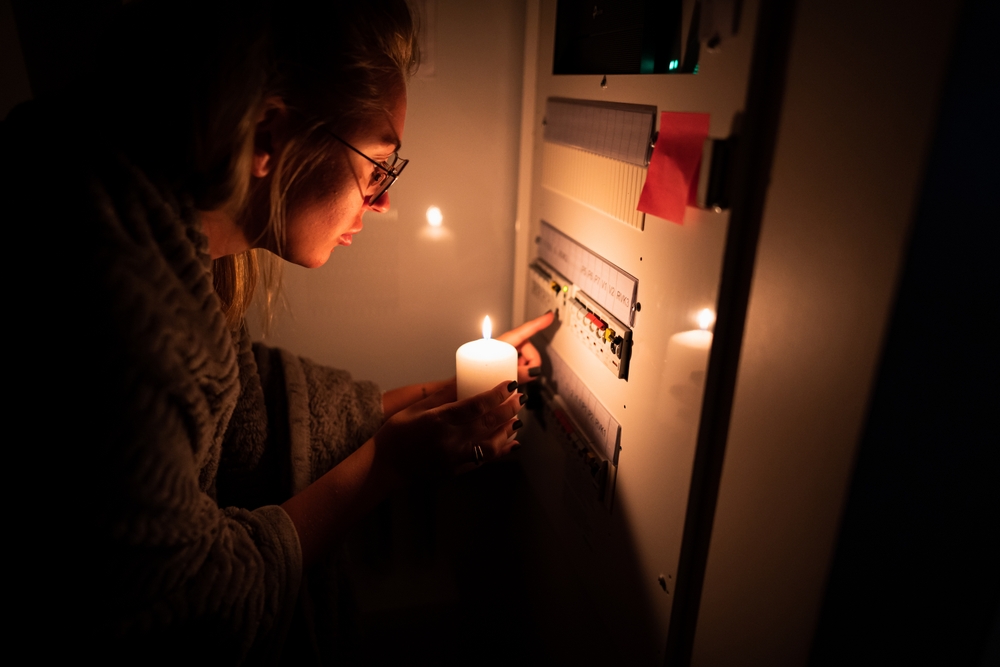Although Denmark is at the forefront when it comes to security of supply, it can also affect us.
In June 2024, Energinet was asked to increase preparedness from green (low threat) to yellow (medium threat). The reason is that the authorities recently raised the threat level for destructive cyber attacks.
In the event of a power failure, you should, according to the national contingency plan able to fend for yourself for up to 3 days in your home, after which you will be able to get help from the emergency services.
So what is the procedure? What do you do in practical terms if the power suddenly fails, all electrical appliances switch off, and you have to find your way around your fuse box in pitch darkness?
Follow the step-by-step guide and safely get through all phases of a power outage.
The 5 steps of the power cut
1.
Check your electrical panel/fuse box
First of all, you need to find out if the power failure is due to something external or a fault in your own system.
You can start by checking whether there are power cuts in your area.
Check with the neighbors as well. If they have power, suspicion falls on your own system. The first step is therefore to check your electrical panel. There is a relay here, which is called either HFI/HPFI, depending on how advanced it is.
The HFI/HPFI relay switches off when the system detects a fault current. If the HFI/HPFI circuit breaker (arrow) or a group fuse (ring) is off, the rocker switches will be down, and then the power cut is likely to be due to a fault in your own electrical system. If all the rocker switches are up, the fault is probably due to external factors.
Here's how to find out for sure whether the error is to be found inside or outside:
- Disconnect all fuse groups in your electrical panel.
- Then press the TEST button on the HFI/HPFI relay.
- If the relay clicks and switches off, then there is power to the control panel, and the fault must be found in your own system. READ 2: Find any errors in your own system
- If, on the other hand, the relay has no reaction, flip up the switch on the HFI/HPFI relay and press TEST again. If the relay still does not respond with a click and interruption, the power interruption has occurred outside your home. READ 3: Orient yourself

2.
Find any errors in your own system
If your relay is off, find out where the fault is in your own system. This is done using the method of exclusion. Do the following:
- Turn off all group switches by flipping the switches down.
- Turn on the HFI/HPFI breaker, then each group breaker one at a time. When the power comes back on, you have found the group where the error occurred.
- Turn off all outlets and appliances in that group. If you're lucky, a careful electrician has written what each group switch supplies power to. Otherwise, you have to try yourself.
- Turn the HFI/HPFI circuit breaker and the faulty group back on. Then turn on the appliances one by one to identify the source of the error.
- Replace the circuit breaker or device causing the error. If the fault is due to the electrical installation, contact an electrician.
- Turn off all electrical equipment and unplug. Leave a single lamp on so you can see when the power returns. (Some devices that contain sensitive electronics may be damaged when the power from the power company comes back on).
3.
Orient yourself
If the power failure is not caused by your own system, it's time to find out. Contact if necessary your network company or look at their website where they report errors. If you are in doubt about which network company you are connected to, you can check Elnet here.
You can also find information at Energinet.dk, which is responsible for the electricity and gas supply systems in Denmark. They often have information about major power outages and general updates about the power grid.
4.
Go to sleep mode
If there is a prospect of a prolonged power failure, the following checklist can help you and the family through the dark time:
- Listen to the radio for updates. The authorities recommend that everyone acquire an emergency radio.
- Be careful of fire hazards if you use candles. Ventilate frequently to avoid carbon monoxide poisoning.
- Communicate with the neighbors and check if there are elderly or disabled people who need help.
- Stock up on candles, matches, flashlights and batteries.
- Provide enough canned food and dry goods that do not require heating.
- If you depend on electricity for heating, keep warm by choosing a south-facing room. Insulate the windows with curtains or blankets.
- Avoid opening the freezer and refrigerator unnecessarily. Every time you open the door, cold air escapes and the temperature rises.
- Make sure you always have the freezer full, possibly with water in containers. A full freezer dries more slowly and the water can be used if the water supply also fails.
- Cover the freezer with a freezer blanket or blanket to insulate and keep the cold longer
- Consider investing in an emergency generator to keep the freezer and refrigerator running during extended power outages. If you live in an apartment, you may want to invest in a UPS (Uninterruptible Power Supply), which is a well-grown battery that provides emergency power for a short period, typically minutes to hours, depending on the system's capacity
5.
Repair the damage
When the power is back on, it's a good idea to check the temperature in the freezer and refrigerator. If the freezer has maintained a temperature below -18°C, the food is probably still good.
Food that still contains ice crystals or is colder than 4°C can be refrozen. Refrigerated food that has been above 4°C for more than two hours should be discarded.
Prepare or eat quickly foods, that have been thawed but are still cold if they cannot be refrozen.
Power failure has blacked out entire countries
Abroad, massive power outages have led to chaos several times. The largest blackout in history affected over 620 million Indians on 30-31. July 2012. The cause was an overload of the power grid, which led to a chain reaction of failing power sources.
And on September 28, 2003, almost all of Italy, with the exception of Sardinia and Elba, was hit by a blackout that lasted up to 12 hours. The blackout was triggered by a storm that damaged power lines from Switzerland to Italy, causing a chain reaction of failing power sources.
At home, however, we can also be involved. Power failure has on several occasions put large parts of Denmark in the black:
September 13, 2015
A fault at a transformer station in southern Sweden's Tommelilla meant that Bornholm at 19.50 lost the power. Parts of southern Sweden were affected by power failure, and when Bornholm bought power through the cable to Sweden during those hours, the island's citizens lost power. Bornholm's own power plant Østkraft immediately set about restoring the supply, but several hours passed before everyone had power again.
December 25, 2013
A ship's anchor tore the submarine cable between southern Sweden and Bornholm. The island's citizens were without power for 1-5 hours.
January 8, 2005
Around 200,000 households across Denmark lost power when a storm with hurricane-force winds hit most of the country. The majority of power outages were caused by distribution lines being damaged by fallen trees and flying objects.
September 23, 2003
Along with southern Sweden, the whole of Eastern Denmark was affected by a power cut. The primary cause was a fault at a switching station in southern Sweden, which led to a voltage collapse in southern Sweden and in eastern Denmark. In Denmark, the first consumers had power after a few hours, and the last ones got power back after approx. six hours.
December 28, 2002
Around one million people in northern and western Jutland were without power for up to three hours as a result of two faults that occurred independently of each other in the West Danish transmission network.




